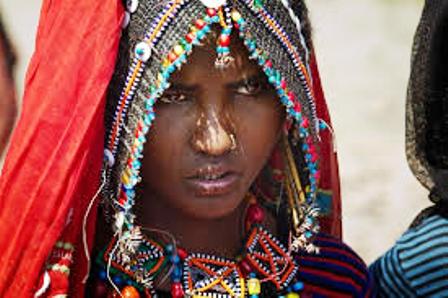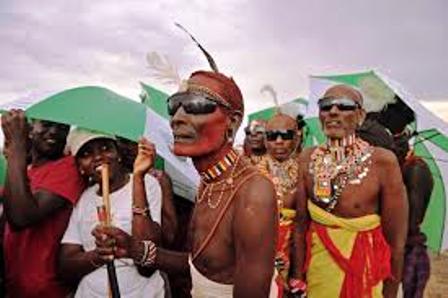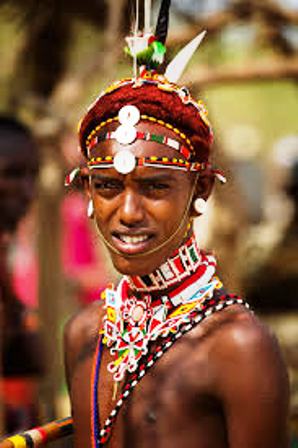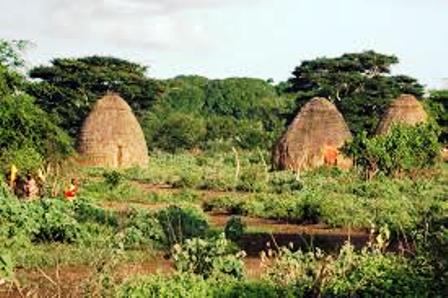Rendile People and their Culture in Kenya
Who are the Rendile people in Kenya? The Rendille are a Cushitic tribe that inhabits the climatically harsh region between Marsabit hills and Lake Turkana in Northern Kenya where they neighbor the Borana, Gabbra, Samburu and Turkana tribes.
They (Rendile) consist of nine clans and seven sub clans. They are culturally similar to the Gabbra, having adopted some Borana customs and being related to the Somali people to the east. Rendille are semi-nomadic pastoralists whose most important animal is the camel. The original home of the Rendille people was in Ethiopia.
History of the Rendile people
The oral history of this Cushitic tribe indicates they are of Jewish descent. They traveled through the Suez Canal through Ethiopia to their present homeland.
They descended through the Cushitic family lines with the Somali people. When the Somali people were traveling from the Suez Canal through Ethiopia the Somali people chose to go toward Somalia for good pastures.
The Rendille people refused to go with them and separated to their present homeland around Marsabit.
They had rejected the land of the Somali's and were thereafter called Rertit. The Somalis consider them rejected people. Their name "Rendille" is a colonial misinterpretation of the word "rertit", which means separated, refused or rejected in the Somali and Rendille languages.
Where are Rendile people located?
The Rendille occupy an area in Northeastern Province of Kenya from the Merille River and Serolivi in the South to Loyangalani in the North from Marsabit and Merti in the East to Lontolio in the West.
The primary towns include Marsabet, Laisamis, Merille, Logologo, Loyangalani, Korr, Kamboi, Ngurunit, and Kargi. The climate of their homeland is semi arid.
What are their lives like?
The Rendille people speak Rendille, which is very close to Somali but is spoken more slowly. Many Rendille also speak Samburu (the tribe neighboring them to the South).
Those of the Rendille language are called Rendille and those who speak Samburu are called Arielle Rendille.
There are about eight or nine sub clans including the Urowen, Dispahai, Rongumo, Lukumai (Nahgan), Tupsha, Garteilan, Matarbah, Otola, and Saale.
The Rendille people are traditionally pastoralists keeping goats, sheep, cattle, donkeys, and camels.
Their nomadic lifestyle is become less prominent with the development of boreholes and centers that allow a more permanent existence.
Traditional dress includes beautiful beads worn by the women around the neck, wrists, and ankles.
Children can often be seen without clothing. The moran wears colorful shukas (clothe wrapped around their bodies) and colors their hair with a mud/mineral mixture.
Men often wear a wrapped cloth rather than trousers. Western clothing is becoming more popular, but more among the men than the women.
Rites of passage include the young men (moran) living in the bush, learning traditional skills, and undergoing traditional circumcision.
Men marry after circumcision and the time of becoming a moran is as young as about eighteen to twenty years.
Young girls are often "booked" at a very early age by older men. They marry as young as ten or twelve years.
They learn skills of women and undergo female circumcision (female genital mutilation, FGM) prior to marriage. Polygamy is part of the tradition.
A wealthy man may have five wives. Elders and chiefs are the leaders of the traditional community. Death rituals include a celebration day when the clothes and belongings of the deceased are given as gifts to those attending.
What are their beliefs?
The Rendille people have a traditional religion that includes prayer to the moon, animal sacrifices, and the existence of ancestral spirits. They also have traditional religious practices that resemble Jewish practices.
The name of god is Wakh. Prayer is offered looking up to the heavens.
The moon plays an important part in the religion. The moon is god or represents god. On the night of the new moon the firstborn son of each family blows a horn. Individuals put red paint made from clay on their skin and hair.
They burn incense from local trees in the fire. Prayers are prayed to the god of the new moon at 8 PM.
A prayer for long life includes putting your hand out toward the new moon and praying, "You take the short life and give me the long life."
At the time of eclipse one prayers, "God, our father, don't die, be alive." And after the moon shines again, "Our god is alive and he is with us."
During draught some take little lambs to the raga or laga (dry river bed) and sacrifice them to god asking for rain. Others go to Mount Moile where the women sing and pour milk and men offer sacrifices of goats to the gods and ask for rain.
Ancestral spirits of deceased men must be appeased. Among some of the Rendille, after a man dies, the manyatta will be burned, a sheep slaughtered, and the family must move to another place.
When they pass by the place milk, water, or tobacco will be placed on the grave to appease the spirit of the deceased.
The traditional witch doctor, called lariboni, practices sorcery to assist people with healing, delivering of mad people, etc. A diviner or foreteller called oloiboni also plays a role in the society.
The Rendille oral history includes a tradition of coming from the Israelite line
.
Most striking in this history is their Passover ceremonies called Sorio (literally sacrifice to God), which includes slaughtering sheep by the firstborn son of the family, putting the blood on the doorposts of their homes.
Blood is also put on the back of camels and other animals, on women's ear and cheek, and on men's chest and forehead.
This is done so that bad omen will not come to the house and animals. Meat from the slaughtered sheep is eaten by all members of the family and shared with those who did not slaughter.
There is a place in every village called nahapo. This is a place of watching and prayer. A fire burns there that is never to go out.
Wood is place on the fire each day. Every night the men of the village meet there at 8 PM. One man is designated to lead in prayer. He comes from the Saale sub clan. The Saale men are designated as the prayer men clan.
The Rendille people exist as a strategic tribe between the Muslims to the North and animistic and Christian tribes to the South.
When Islam came to the region and efforts were made by the Muslims to convert the Rendille to Islam the Rendille refused to become Muslims.
The Muslims insisted that prayer to Allah be made with their faces to the ground. The Rendille believed that prayer should be made with their faces toward the heavens.
On one occasion the Rendille gathered all the Koran that had been distributed among them and took them to Mount Moile and burned them there. Some Rendille continued to be Muslim since early times, but the percentage was small.
More about Afican Culture
Kenya Art |
Kenya Festivals |
Kenya Gender Issues |
Kenya Gestures |
Kenya Greetings |
Kenya History |
Kenya Language |
Kenya Literature |
Kenya Modern Culture |
Kenya Music |
Kenya National Anthem |
National Dress Cord of Kenya |
Kenya People |
Kenya Respect |
Kenya Taboos |
Kenya Television and Culture |
Recent Articles
-
Garam Masala Appetizers ,How to Make Garam Masala,Kenya Cuisines
Sep 21, 14 03:38 PM
Garam Masala Appetizers are originally Indian food but of recent, many Kenyans use it. Therefore, on this site, we will guide you on how to make it easily. -
The Details of the Baruuli-Banyara People and their Culture in Uganda
Sep 03, 14 12:32 AM
The Baruuli-Banyala are a people of Central Uganda who generally live near the Nile River-Lake Kyoga basin. -
Guide to Nubi People and their Culture in Kenya and Uganda
Sep 03, 14 12:24 AM
The Nubians consist of seven non-Arab Muslim tribes which originated in the Nubia region, an area between Aswan in southern











New! Comments
Have your say about what you just read! Leave me a comment in the box below.